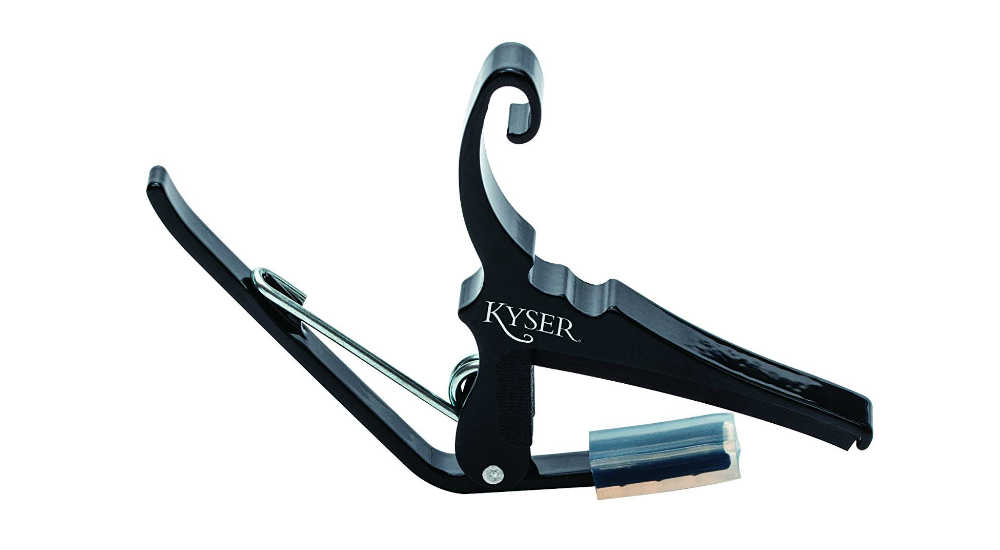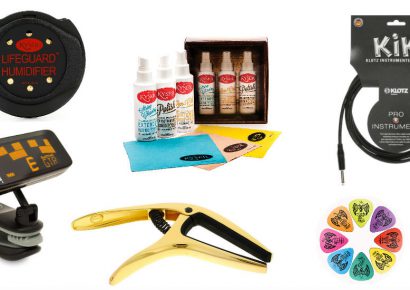If you’ve ever bought an acoustic guitar from a brick-and-mortar store, there’s a high chance you’ve already encountered a Kyser capo in one form or another. Kyser offers a plethora of options to choose from, and each capo – while fundamentally similar – performs different duties to an exemplary standard. We’ve got a myriad of Kyser products to talk about in this review, including full-sized capos, partial-sized capos, and even an acoustic humidifier and a guitar cleaning kit. Let’s dive right in!
The Kyser Quick-Change acoustic capo is where it all began. The review unit sent to us was finished in a breathtaking ‘rosewood’ colour scheme, consisting of black tiger stripes overlaid on top of a dark red wood grain pattern. Aesthetically, this capo is a winner. It pairs well with almost every guitar colour and finish imaginable. Most distinctive of all is its top arm, which is stylishly furled upwards into a slight spiral, mirroring the snazzy, cursive ‘K’ in the Kyser brand logo.
The Quick-Change acoustic capo is constructed from lightweight aluminium, featuring a single-handed action bound by a high-tension coil. A thick sheet of rubber coats the top jaw of the capo, while a block of transparent white rubber rests at the bottom. It’s slightly regrettable – a black rubber block would have suited the overall colour scheme much better. Minor gripes aside, the capo functions as it should. Clamping, releasing and shifting the device is as simple as it could be. The pressure applied to the fretboard was evenly dispersed and never made me worry about whether my frets were under unnecessary duress. Performance was excellent across the entire fingerboard. There were no dead spots, buzzing or rattling to speak of.
Following the acoustic capo is the Quick-Change electric variant. Like all Kyser capos, this one is forged from sturdy aluminium then hand-drilled and assembled in Texas, USA. In terms of shape and looks, the electric capo is identical to its acoustic peer. Again – tough rubber coating beneath the top arm, and a transparent rubber block on the lower. According to Kyser, the main difference between the two is its smaller body, smaller radius, and a lower spring tension. This is specifically tailored towards vintage guitars with a 7.25” fretboard radius, as well as the more commonly found 9.5” radius found across most standard electric guitars these days.
The remaining three capos are functionally unique. However, the Pro/AM capo is by far the smallest and most bare-bones out of them all. It’s made from raw, unfinished aluminium and features two thick wads of rubber on the ends of each arm. Clamping is performed via a manually adjustable tension screw. While slightly tedious, precise adjustments can be achieved for more fragile instruments. However, you can forget about leaving this capo on your guitar’s headstock. Unscrewing the tension screw to remove it each time is way too much of a hassle. Due to its laborious nature, this capo would be best suited as a secondary or backup capo.
Let’s talk about the final two capos at once: the Kyser Quick-Change for drop-D tunings, and the Kyser Short-Cut. Both capos are built for alternate tunings – obviously drop-D for the former, and any wild tunings for the latter. Structurally, the drop-D Quick-Change capo is a mirror image of the Kyser Quick-Change for electric guitars. However, it specifically covers only five of the six strings on your guitar, allowing for some interesting chords to be played. While plainly promoting the use of drop-D tuning, Kyser also recommends experimenting with BGDGBD with the capo on the fourth fret, or CADGBD on the third fret. This spirit of experimentation is further compounded in the Short-Cut. Instead of five strings, this capo only bars a mere three (the A, D, and G strings), and is definitely best suited for the more experimental players out there. Alternative, progressive and math rockers, this one is definitely for you.
The penultimate item in the Kyser care package is the trio of cleaning/conditioning products. The instrument polish, lemon oil fretboard conditioner, and the string cleaner. Each comes in an adorable spray bottle, plastered with its own colourful and stylish font. I put these to work on a slightly dried out Epiphone ES-339, and it didn’t take long for the guitar to shine once again. The lemon oil conditioner worked wonders on the 339’s dark Pau Ferro board, hydrating it without a trace of stickiness. The same effects were experienced with the instrument polish, which removed slight marks and fingerprints with aplomb. The string cleaner was my personal favourite of the three; it works by getting into the microgrooves between each string’s metal winds, and forms a barrier to protect against corrosion, sweat and debris. While it certainly made the strings feel slick, they weren’t slippery in the slightest.
The final item is the Lifeguard Humidifier, an unsung hero in safeguarding your acoustic guitar against the elements. Owning a guitar can often be a large investment, and thus ensuring its longevity should be your utmost priority. If your guitar occasionally travels with you overseas or if you live in a dry, arid climate, a humidifier is absolutely necessary to preserve the wood of your guitar.
With such an all-encompassing line of guitar accessories, Kyser is a veritable one-stop shop for all guitar-related paraphernalia. Considering the excellent quality of their longevity products and their lifetime guarantee on all their capos, you can be assured that a Kyser product will never let you down.







